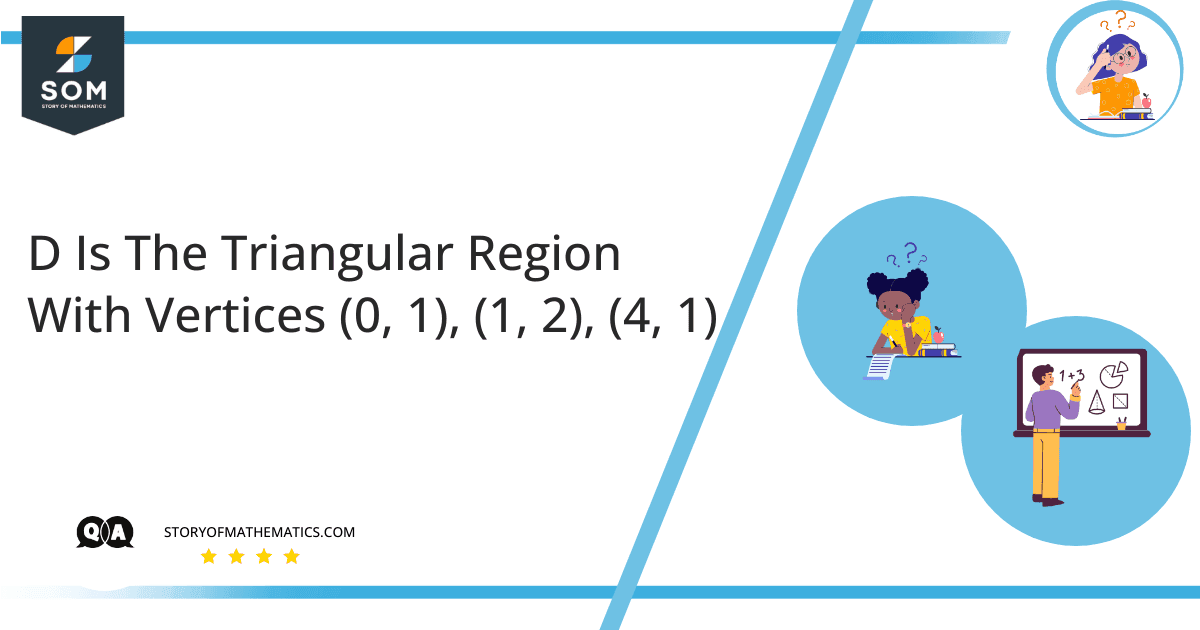
This article aims to find the double integral of the triangular region with vertices. This article uses the concept of double integration. The definite integral of a positive function of one variable represents the area of the region between graph of the function and the $x-axis$. Similarly, the double integral of a positive function of two variables represents the volume of the region between the defined surface function (on the three-dimensional Cartesian plane, where $z = f(x, y)$ ) and the plane that contains its domain.
Expert Answer
The points are:
\[P (0,1) , Q(1,2) \: and \: R(4,1)\]
The equation of line between $P$ and $R$ is given as:
\[y = 1\]
The equation of line between $P$ and $Q$ is given as:
Slope-intercept equation is given as:
\[ y = mx +c\]
The slope is:
\[m_{1} = \dfrac{2-1}{1-0} =1 \]
\[m_{1} = 1\]
and the line is passing over the point:
\[x = 0\: , y = 1\]
\[1 = 0+ b\]
\[b = 1\]
\[y = x+1\]
\[x = y-1\]
The equation for the line between $ Q $ and $ R$ is:
\[m_{2} = \dfrac{(1-2)}{(4-1)} = -\dfrac{1}{3} \]
\[y = (-\dfrac{1}{3}) \times x +b\]
\[x =1 , y =2\]
\[2 = (-\dfrac{1}{3}) \times 1+ b \]
\[b = \dfrac{7}{3}\]
\[y = -(\dfrac{x}{3})+ \dfrac{7}{3}\]
\[x = 7 -3y \]
The double integral becomes:
\[A = \int \int y^{2} dx dy\]
\[A = \int y^{2} dy\int dx \]
\[A = \int y^{2} dy\int dx \]
\[A = \int_{1}^{2} y^{2} dy \times x |_{(y-1)}^{(7-3y)} \]
\[A = \int_{1}^{2} y^{2} dy \times (7-3y) – (y-1) \]
\[A = \int_{1}^{2} y^{2} dy \times (8-4y )\]
\[A = \int_{1}^{2} (8 y^{2} -4y^{3}) dy\]
\[= (\dfrac{8}{3} y^{3} – y^{4}) |_{1}^{2}\]
\[= \dfrac{56}{3} -15 \]
\[A = \dfrac{11}{3}\]
Numerical Result
The solution is $ A = \dfrac{11}{3}\: square\:units $.
Example
Evaluate the double integral. $4 y^{2}\: dA$, $D$ is a triangular region with vertices $(0, 1), (1, 2), (4, 1)$.
Solution
The points are:
\[P (0,1) , Q(1,2) \: and \: R(4,1)\]
The equation of line between $P$ and $R$ is given as:
\[y = 1\]
The equation of line between $P$ and $Q$ is given as:
Slope-intercept equation is given as:
\[ y = mx +c\]
The slope is:
\[m_{1} = \dfrac{2-1}{1-0} =1 \]
\[m_{1} = 1\]
and the line is passing over the point:
\[x = 0\: , y = 1\]
\[1 = 0+ b\]
\[b = 1\]
\[y = x+1\]
\[x = y-1\]
The equation for the line between $ Q $ and $ R$ is:
\[m_{2} = \dfrac{(1-2)}{(4-1)} = -\dfrac{1}{3} \]
\[y = (-\dfrac{1}{3}) \times x +b\]
\[x =1 , y =2\]
\[2 = (-\dfrac{1}{3}) \times 1+ b \]
\[b = \dfrac{7}{3}\]
\[y = -(\dfrac{x}{3})+ \dfrac{7}{3}\]
\[x = 7 -3y \]
The double integral becomes:
\[A = 4\int \int y^{2} dx dy\]
\[A = 4\int y^{2} dy\int dx \]
\[A = 4\int y^{2} dy\int dx \]
\[A = 4\int_{1}^{2} y^{2} dy \times x |_{(y-1)}^{(7-3y)} \]
\[A = 4\int_{1}^{2} y^{2} dy \times (7-3y) – (y-1) \]
\[A = 4\int_{1}^{2} y^{2} dy \times (8-4y )\]
\[A = 4\int_{1}^{2} (8 y^{2} -4y^{3}) dy\]
\[= 4(\dfrac{8}{3} y^{3} – y^{4}) |_{1}^{2}\]
\[=4(\dfrac{56}{3} -15) \]
\[A = 4(\dfrac{11}{3})\]
\[A = \dfrac{44}{3}\]
The solution is $ A = \dfrac{44}{3}\: square\:units $.
